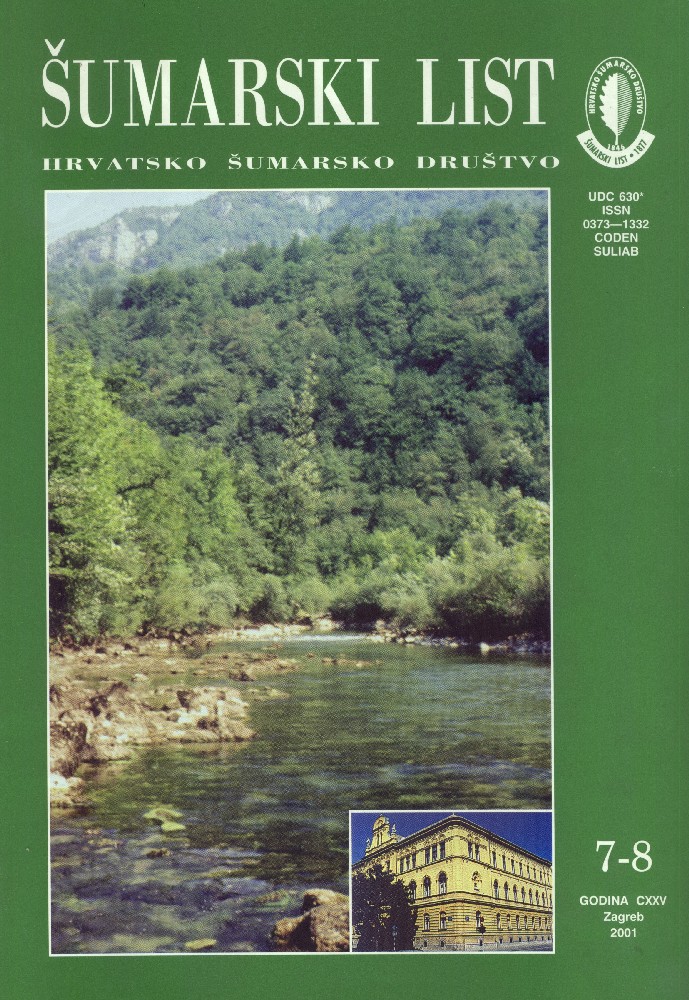
broj: 7-8/2001
pdf (25,7 MB) |
|
||||||||||||||
| IZVORNI ZNANSTVENI ČLANCI | ||
| Vučetić, M. | UDK 630* 111+431 | |
| Weather Conditions and Forest Fires on the Coastal Area of Croatia During 2000 pdf HR EN | 367 | |
| PREGLEDNI ČLANCI | ||
| Prpić, B. | UDK 630* 263 + 116 | |
| The Effects of Hydro-technical Interventions on the Stabilitv of Pedunculate Oak (Quercm robur L.) Stands in Croatia on the Example of the Novo Virje Hydro-power Station pdf HR EN | 379 | |
| Šporčić, M., Vondra, V. | UDK 630* 945 | |
| Master´s Theses, Defended at the Faculty of Forestry in Zagreb, Upgrade Forestry pdf HR EN | 391 | |
| Grubešić, M. | UDK 630* 156 + 451 | |
| Waldbau und Wildverwalten mit Hinsicht auf die Probleme in deutschen Waldern pdf HR EN | 405 | |
| Zelić, J. | UDK 630* 288 | |
| The Role of Silkvvorm (Bombyx mori) and White Mulberry (Morus alba) in Silkvvorm Breeding and Sericulture pdf HR EN | 413 | |
| Summary: Silk has long been known in China through the cultivation of silkworm (Bombyx mori) and through the cultivation of mulberries (Morus alba). Silk fabric from China has been exported to Europe since the 6th century.Silk production first commenced in Eastern Mediterranean. Dalmatian cities held primacy in this respect through their trade with southern Italy. Under the Turkish dominion, in the urban areas silk was produced for fine shirts, belts and scarves. Silk production was introduced to Croatia in the 18th century with the planting of mulberry trees (Morus alba). The deliberate agri-cultural policies of Austrian authorities (mercantilism) were introduced into the northern areas of Croatia, as well as western and eastern Slavonia. Production was encouraged to meet the needs of manufacturing and to start the silk industry. Silk fabric was incorporated in the local folklore. Silk production sometimes constituted part of peasant economv. It is assumed that every cultural or ethnological phenomenon contains a code of history, but also various codes of regional, ethnic, national, religious and certainly social characteristics. The issue of revitalising this industry is very topical today. Silk worms (Mombyx mori) were raised in spring when mulberry trees (Morus alba) on which they fed began to leaf. The eggs, which had been kept in a cold place, were then placed in a warm part of the house. Key words: economic silk production; mulberry (Morus alba); silk as a cultural phenomenon; silk factory; silk production; Silkworm (Bombyx mori) | ||
| STRUČNI ČLANCI | ||
| Vukelić, M. | UDK 630* 902 + 233 | |
| Laudonov Gaj pdf HR EN | 425 | |
| Grospić, F. | UDK 630* 902 + 469 | |
| A Contribution to Assessing the Conditions in the Forestrv of Lika in the Second Part of the 19th Century pdf HR EN | 437 | |
| Božičević, I. | UDK 630* 648 | |
| A Model for Writing and Drawing up Forest Records for all Forest Enterprises in the Delnice Forest Administration pdf HR EN | 443 | |


